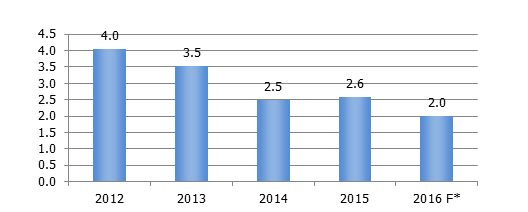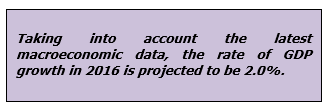Macroeconomic forecasts
For Latvijas Banka Monthly Newsletter, In Focus, June 2016
Latvia's economic growth remains moderate: according to seasonally and calendar adjusted data, GDP increased by 2.6% in 2015. In general, the economic growth currently relies on strong private consumption, which offsets, to a certain extent, the weak external demand and absence of steadiness in investment growth. At the current junction, external factors do not support export and investment acceleration; hence measures leading to improvements in Latvia's business environment and other areas of activity via structural reforms aimed at boosting economy's competitiveness are gaining in importance.
Real GDP growth, %

Recent macroeconomic data have been relatively weak. After the GDP drop in the fourth quarter of 2015, the data for the first quarter of 2016 likewise have been sluggish: growth was merely symbolic – one tenth of a percent (0.1% quarter-on-quarter, seasonally adjusted data). Economic growth in Latvia was primarily impeded by the low investment activity. The decrease in the amount of investment reflects the poor results of the construction sector – a year-on-year drop of 19% in value added. This confirms the previously expressed concerns by Latvijas Banka about the dependence of the construction sector and investments on the availability of the European Union (EU) structural funds. However, it should be stressed that the sharp drop in the construction sector output is only a temporary factor as it is expected that access to EU funding will improve towards the end of 2016. Also, private consumption has been somewhat lagging behind the rise in disposable income of households, pointing to a tendency to keep rainy-day savings or to hold back funds for larger purchases in the future, which in turn leads to a potential upside risk in the medium term. The above suggests that 2016 will be marked by somewhat slower growth.
 In March 2016 Latvijas Banka reduced its GDP projection for 2016 from 2.7% to 2.3%. The change was determined by the tense geopolitical situation, worsening of external demand and weak investment dynamics. Taking into account the latest macroeconomic data, growth projections are lowered further – the rate of GDP growth in 2016 is projected to be 2.0%. Given the expected rise in the external demand and higher investment activity, related to a renewed flow of EU funds, GDP is forecast to increase by 3.0% in 2017 or even slightly higher.
In March 2016 Latvijas Banka reduced its GDP projection for 2016 from 2.7% to 2.3%. The change was determined by the tense geopolitical situation, worsening of external demand and weak investment dynamics. Taking into account the latest macroeconomic data, growth projections are lowered further – the rate of GDP growth in 2016 is projected to be 2.0%. Given the expected rise in the external demand and higher investment activity, related to a renewed flow of EU funds, GDP is forecast to increase by 3.0% in 2017 or even slightly higher.
In 2015, average inflation (HICP) stood at 0.2%. Its year-on-year decline was primarily on account of commodity (e.g. oil and agricultural and food products) price falls on a global scale, while upward contribution to inflation came from the domestic factors like a gradual increase in income and some administrative price rises. The average consumer price level (CPI) in the first five months of this year was lower than a year ago, this trend still being a result of low world energy prices or largely their lagging effect. Heating energy prices, for example, are still continuing to fall, despite the fact that the prices of oil products and natural gas have begun to recover in the world market. Even though inflation is gradually going to change course in the coming months due to growing global commodity prices and gradually unwinding negative cost factors, the negative annual inflation in the first half of the year suggests that there will be a negative average annual inflation of 0.4% in 2016. Although some deceleration in wage growth is forecasted, the demand side effect on inflation will be maintained by gradual renewal of lending. With an outlook of growing commodity prices and rising disposable income, inflation for 2017 is expected to return to a positive figure of 1.3%.
Textual error
«… …»






